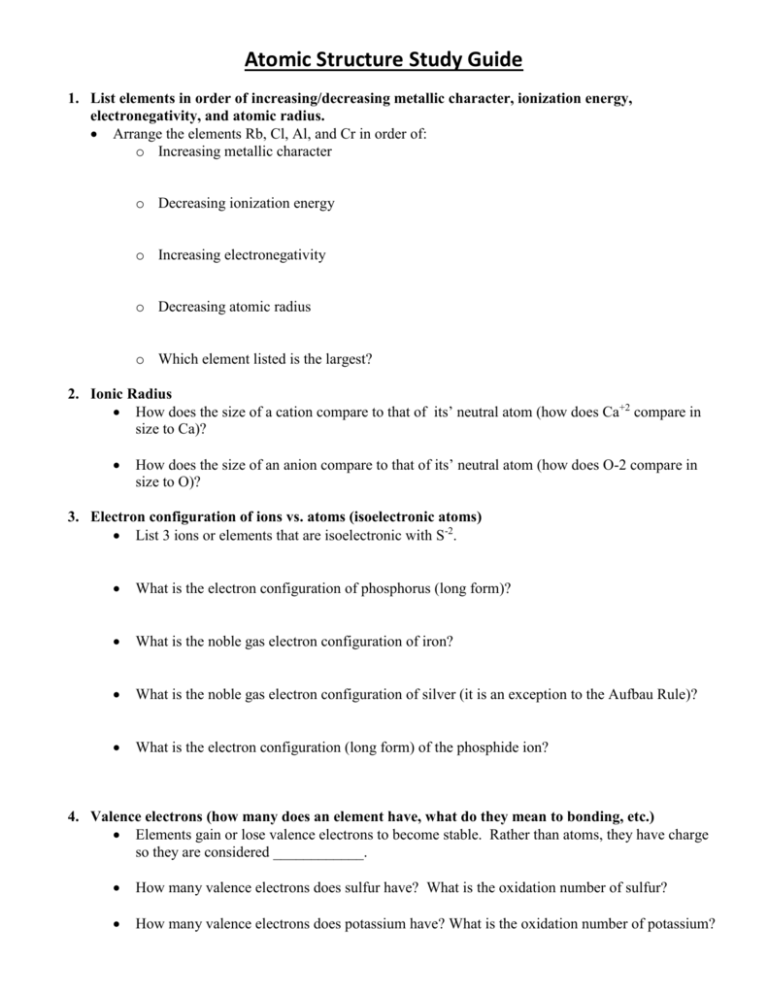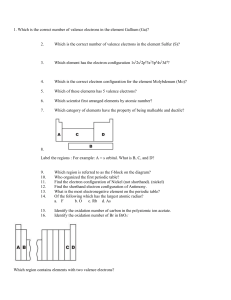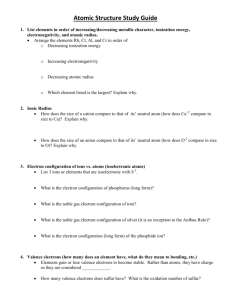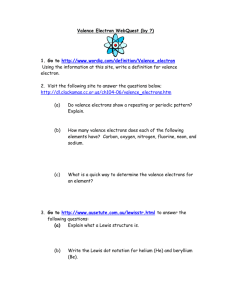Atomic Structure Study Guide List elements in order of increasing
advertisement

Atomic Structure Study Guide 1. List elements in order of increasing/decreasing metallic character, ionization energy, electronegativity, and atomic radius. Arrange the elements Rb, Cl, Al, and Cr in order of: o Increasing metallic character o Decreasing ionization energy o Increasing electronegativity o Decreasing atomic radius o Which element listed is the largest? 2. Ionic Radius How does the size of a cation compare to that of its’ neutral atom (how does Ca+2 compare in size to Ca)? How does the size of an anion compare to that of its’ neutral atom (how does O-2 compare in size to O)? 3. Electron configuration of ions vs. atoms (isoelectronic atoms) List 3 ions or elements that are isoelectronic with S-2. What is the electron configuration of phosphorus (long form)? What is the noble gas electron configuration of iron? What is the noble gas electron configuration of silver (it is an exception to the Aufbau Rule)? What is the electron configuration (long form) of the phosphide ion? 4. Valence electrons (how many does an element have, what do they mean to bonding, etc.) Elements gain or lose valence electrons to become stable. Rather than atoms, they have charge so they are considered ____________. How many valence electrons does sulfur have? What is the oxidation number of sulfur? How many valence electrons does potassium have? What is the oxidation number of potassium? How many valence electrons does phosphorus have? How many inner shell electrons does phosphorus have? What is the oxidation number of an element with electron configuration [Ar]4s1? What would the formula of the compound be if it combines with sulfur. How many electrons fit in the first energy level? The second energy level? The third energy level? The fourth energy level? 5. Energy, wavelength, frequency and speed of electromagnetic waves (be able to do calculations) What is the energy of a photon of microwave radiation with a frequency of 3.20 x 1011 s-1? What is the frequency of radiation with a wavelength of 5.00 x 10-8 m? Convert 1.3 x 10-9 m into nanometers. 6. Orbital notation Draw the orbital notation for nitrogen. How many half-filled orbitals does nitrogen have? Draw the orbital notation for oxygen. How many filled orbitals does oxygen have? 7. Paramagnetic/Diamagnetic What is the difference between paramagnetic and diamagnetic? Draw the orbital notation for molybdenum (exception to the Aufbau Rule). Would it be paramagnetic or diamagnetic? 8. Electromagnetic Radiation What are the types of electromagnetic radiation? Which type has the highest energy? The highest frequency? The longest wavelength? What are the colors of light in order of increasing frequency? 9. Atomic Symbols number of neutrons, protons and electrons based on nuclear notation (Isotopes) What is an isotope? How many neutrons does Phosphorus-31 have? How many protons, neutrons, and electrons are in a neutral atom of 239 U? 10. First, Second, Third Ionization Energies What happens to ionization energy with each successive electron removed from an atom? How many valence electrons does an element have if it’s first eight ionization energies are as follows: Ionization Energy Enthalpy /kJ mol-1 1st 1313.9 2nd 3388.3 3rd 5300.5 4th 7469.2 5th 10,989.5 6th 13,326.5 7th 71,330 8th 84,078.0 Which period 2 element are these ionization energies for? 11. Quantum numbers (be very familiar with these) What does each quantum number stand for and what are their possible values? Silicon has 4 valence electrons. Give probable quantum numbers for each of the four valence electrons. Which sublevels (s, p, d, and f) are in the 1st energy level? The second energy level? The third energy level? The fourth energy level? 12. Electron Dot Diagrams Draw the electron dot diagram for oxygen. Based on the dot diagram, what is the oxidation number of oxygen and why? 13. Properties & Locations of Groups/Families Name the family(ies) that is/are: i. Radioactive ii. Form cations iii. Form anions iv. Contain fluorine and bromine v. Have full s and p sublevels vi. Begin filling the 4f sublevel vii. Begin filling the 5f sublevel 14. Excited vs. Ground State What is the difference between excited and ground state? How much energy is emitted when an electron moves from n = 4 to n = 2?



![The electronic configuration of phosphorus is [Ne] 3s2 3p3](http://s3.studylib.net/store/data/008974852_1-8381577ce936fbfa611892c1a5f109cd-300x300.png)



